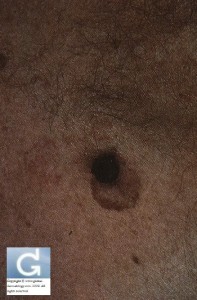How to examine moles on your own (self-examination of melanocytic navi (naevi))
- We advise you to have your moles examined by a dermatologist, most especially if:
- you have more than 100 moles
- an individual in your family has had a melanoma
- you are 40 years old
- you have light-colored (coloured) (photoypes I and II) and/or blue, green eyes
- you get easily sunburnt
- you are worried
- We advise you to have your moles examined once a year by a dermatologist. He/her will examine them with a tool called a dermatoscope or even a videomicroscope.
- To increase the chances of detecting an abnormal mole with could be a melanoma, we advise you to check your moles yourself once a month. This will also enable you to get use to the appearance of your moles and know if new ones appear.
- To do this:
- go into a private and well-lit room
- face a head-to-feet mirror and hold a moveable mirror to examine normally non visible areas (back, back of the legs)
- be consistent and examine your body in a rigorous systematic way (head to feet, front and back):
- head
- neck
- arm (right and left)
- chest and upper back
- abdomen, genital organs and lower back/buttocks
- leg (right and left)
- finish by looking at the palms of the hands and between the fingers, plantar surfaces of the feet and between the toes and mucosal surfaces (eyes, mouth, and anal orifice).
- ask someone to look at your scalp by blowing the hairs apart with a hairdryer.
-
As a general rule, you should then consult a dermatologist if a mole:
- has an irregular shape (A like asymmetry)
- has an irregular border (B like border)
- has many colors (colours) (C like color (colour))
- has a diameter more than a quarter of an inch (5mm) (D like diameter)
- has changed since last time (E like evolving).
- You have to pay particular attention and consult if a mole:
- not previously there appears
- grows
- bleeds spontaeously
- doesn’t heal after trauma
Contributors:
Dr Christophe HSU – dermatologist. Geneva, Switzerland
Category : auto-examen des naevi (névi) mélanocytaires - Modifie le 06.5.2010Category : examine common moles yourself - Modifie le 06.5.2010Category : examiner soi-même ses grains de beauté - Modifie le 06.5.2010Category : self-examination of melanocytic nevi - Modifie le 06.5.2010



